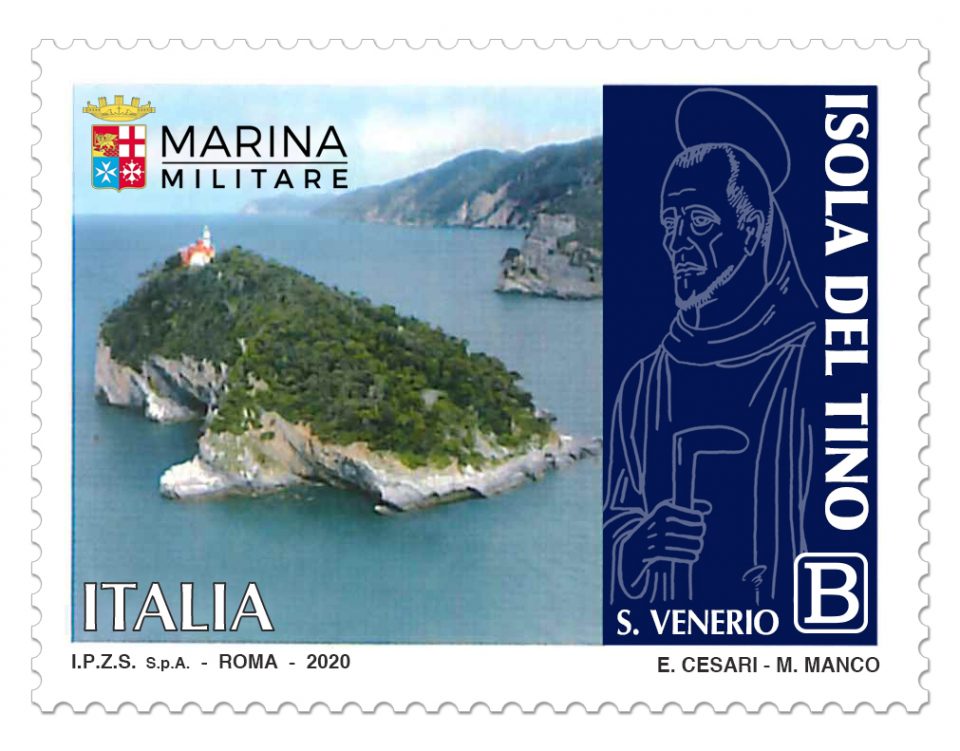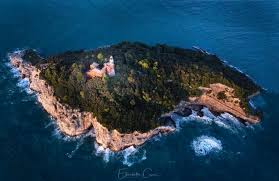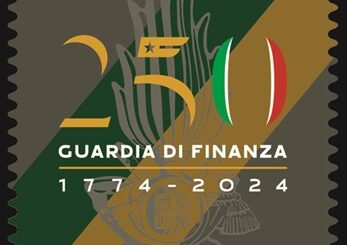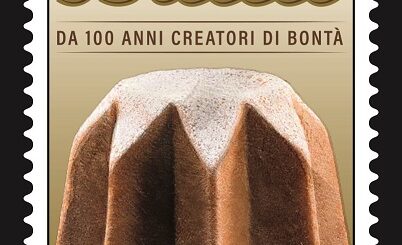POSTE ITALIANE 34^ emissione del 11 Settembre 2020 di un francobollo ordinario appartenente alla serie tematica: “il Patrimonio naturale e paesaggistico” dedicato all’Isola del Tino
POSTE ITALIANE 34^ emissione del 11 Settembre 2020 di un francobollo ordinario appartenente alla serie tematica: “il Patrimonio naturale e paesaggistico” dedicato all’Isola del Tino

Il Ministero dello Sviluppo con le Poste Italiane emette 11 Settembre 2020 di un francobollo ordinario appartenente alla serie tematica: “il Patrimonio naturale e paesaggistico” dedicato all’Isola del Tino, relativo al valore della tariffa B, corrispondente ad € 1.10.
- data: 11 settembre 2020
- dentellatura: 11
- stampa: rotocalcografia
- tipo di carta; carta bianca patinata neutra -autoadesiva non fluorescente
- stampato: I.P.Z.S. Roma
- tiratura: 400.000
- dimensioni: 40 x 30 mm
- contenuto foglio: 45 esemplari
- valore: B= €1.10
- bozzettista: Elisabetta Cesari e Mauro Manco
- num. catalogo: Michel 4059 YT _______ UN ________
Se sei interessato all’acquisto di questo francobollo lo puoi acquistare al prezzo di € 1.50. Inviandomi una richiesta alla email: protofilia1@gmail.com
L’isola del Tino si trova nel Mar Ligure, all’estremità occidentale del Golfo della Spezia; il suo territorio fa parte del comune di Porto Venere. Dista 500 m dall’Isola Palmaria e 2,5 km dalla terraferma.

Dal 1997 l’isola del Tino, insieme alle altre isole Palmaria e Tinetto, Porto Venere e le Cinque Terre è stata inserita tra i Patrimoni dell’umanità dell’UNESCO.
DESCRIZIONE
L’isola del Tino (Tyrus mayor nei testi medievali) può essere considerata, fra le tre isole del Golfo, come quella “intermedia”, sia come dimensioni, sia come posizione. A Nord infatti troviamo l’isola Palmaria, la più estesa, mentre a Sud è l’isolotto del Tinetto, di dimensioni più ridotte. Entrambe queste due isole distano dal Tino solo alcune decine di metri.
La superficie dell’isola è di 0,13 km² e il suo perimetro di quasi 2 km.
Un faro del XIX secolo è costruito sulla sommità dell’isola.
Storia
San Venerio, nato nell’isola della Palmaria e patrono del Golfo della Spezia, visse in eremitaggio sull’isola sino alla sua morte, avvenuta nel 630.
In sua memoria sulla sua tomba fu costruito dapprima un piccolo santuario nel VII secolo da Lucio, vescovo di Luni e più tardi, nell’XI secolo, un monastero Benedettino che arrivò a godere di ampia fama e ricevere frequenti donazioni dai nobili dei paesi circostanti; ai monaci benedettini successero gli Olivetani nel 1435, sotto il pontificato di Eugenio IV, i quali vi rimasero fino al 1446. I ruderi del monastero sono tuttora visibili sulla costa settentrionale dell’isola.
Nell’estate del 1242, davanti all’isola del Tino, Genova si prende rivincita della battaglia del Giglio sconfiggendo la flotta pisana alleata dell’imperatore Federico II.
Flora
La flora prevalente nell’isola è costituita dalla macchia mediterranea e dal bosco di leccio.
Altre importanti formazioni vegetali sono la macchia ad euforbia (uphorbia dendroides) e, sulle scogliere più vicine al mare, quelle caratterizzate dal finocchio di mare (Crithmum maritimum).
Inoltre molto presenti sono anche: la cineraria marittima (Senecio Cineraria), il papavero cornuto (Glacium flavum), la ginestra (Spartium junceum), il fico degli ottentotti (Carpobrotus acinaciformis), la centaurea veneris, la valeriana rossa (Centranthus ruber), la ruta (Ruta graveolens).
Sono presenti anche alcune piante aromatiche come il timo (Thimus vulgaris), il mirto (Myrtus communis), il rosmarino (Rosmarinus officinalis) e l’ampelodesma mauritanica.
Fauna
La fauna del Tino è molto simile a quella della Palmaria, a motivo della vicinanza tra le due isole.
Sull’isola si trovano alcune delle maggiori emergenze faunistiche rettili, quali il tarantolino Phyllodactylus europaeus, il più piccolo dei gechi europei, facilmente riconoscibile per l’assenza di tubercoli sul lato dorsale. Oltre che sulle isole del Tino e del Tinetto questo geconide è presente in pochissimi altri siti liguri.
Tra gli uccelli ricordiamo il gheppio (Falco tinnunculus), il falco pellegrino (Falco peregrinus), lo sparviero (Accipiter nisus), la pernice rossa (Alectoris rufa), i gabbiani (Larus argentatus, Larus michahellis), il corvo imperiale (Corvus corax), il passero solitario (Monticola solitarius), il cormorano o marangone dal ciuffo (Phalacrocorax aristotelis).
Nell’isola l’elevata presenza di uccelli è dovuta alla quasi totale assenza dell’uomo. Questo ha fatto sì che gli uccelli (in particolare i gabbiani) nidificassero indisturbati anche nei posti più impensabili dell’isola.
Archeologia subacquea
Nel 2014 ricerche subacquee condotte a 17 miglia a sud dell’isola del Tino, ad una profondità di circa 400 m, hanno scoperto il relitto di una nave romana di età repubblicana del II secolo a.C.; la nave naufragata trasportava un carico di anfore vinarie di tipo greco-italico e costituisce la testimonianza dei traffici marittimi tra Roma, la Gallia e la Spagna.
POSTE ITALIANE 34th issue on 11 September 2020 of an ordinary stamp belonging to the thematic series: “Natural and landscape heritage” dedicated to the Island of Tino

date: 11 September 2020
indentation: 11
printing: rotogravure
Type of paper; neutral white coated paper – self-adhesive non-fluorescent
printed: I.P.Z.S. Rome
circulation: 400,000
dimensions: 40 x 30 mm
sheet content: 45 copies
value: B = € 1.10
sketch artist: Elisabetta Cesari and Mauro Manco
num. catalog: Michel______ YT ________UNIF_________
If you are interested in purchasing this stamp, you can buy it for € 1.50. By sending me a request to the email: protofilia1@gmail.com
The island of Tino is located in the Ligurian Sea, at the western end of the Gulf of La Spezia; its territory is part of the municipality of Porto Venere. It is 500 meters from the Palmaria Island and 2.5 km from the mainland.
Since 1997 the island of Tino, together with the other islands of Palmaria and Tinetto, Porto Venere and the Cinque Terre has been included among the UNESCO World Heritage Sites.
DESCRIPTION
The island of Tino (Tyrus mayor in medieval texts) can be considered, among the three islands of the Gulf, as the “intermediate” one, both in terms of size and position. In fact, to the north we find the Palmaria island, the largest, while to the south is the smaller island of Tinetto. Both of these two islands are only a few tens of meters away from Tino.
The surface of the island is 0.13 km² and its perimeter is almost 2 km.
A 19th century lighthouse is built on the top of the island.
History
San Venerio, born on the island of Palmaria and patron saint of the Gulf of La Spezia, lived as a hermitage on the island until his death in 630.
In his memory, a small sanctuary was first built on his tomb in the seventh century by Lucio, bishop of Luni and later, in the eleventh century, a Benedictine monastery that came to enjoy widespread fame and receive frequent donations from the nobles of the surrounding countries; the Benedictine monks were succeeded by the Olivetans in 1435, under the pontificate of Eugene IV, who remained there until 1446. The ruins of the monastery are still visible on the northern coast of the island.
In the summer of 1242, in front of the island of Tino, Genoa took revenge of the battle of the Giglio by defeating the Pisan fleet allied with Emperor Frederick II.
Flora
The prevailing flora on the island is made up of the Mediterranean scrub and the holm oak wood.
Other important plant formations are the euphorbia maquis (uphorbia dendroides) and, on the cliffs closest to the sea, those characterized by sea fennel (Crithmum maritimum).
Also very present are: the maritime cineraria (Senecio Cineraria), the horned poppy (Glacium flavum), the broom (Spartium junceum), the Hottentot fig (Carpobrotus acinaciformis), the centaurea veneris, the red valerian (Centranthus ruber), rue (Ruta graveolens).
There are also some aromatic plants such as thyme (Thimus vulgaris), myrtle (Myrtus communis), rosemary (Rosmarinus officinalis) and ampelodesma mauritanica.
Fauna
The fauna of Tino is very similar to that of Palmaria, due to the proximity between the two islands.
On the island there are some of the major reptilian faunal emergencies, such as the tarantolino Phyllodactylus europaeus, the smallest of the European geckos, easily recognizable by the absence of tubercles on the dorsal side. In addition to the islands of Tino and Tinetto, this geconid is present in very few other Ligurian sites.
Among the birds we remember the kestrel (Falco tinnunculus), the peregrine falcon (Falco peregrinus), the sparrow hawk (Accipiter nisus), the red partridge (Alectoris rufa), the gulls (Larus argentatus, Larus michahellis), the raven (Corvus corax) ), the blue rock thrush (Monticola solitarius), the cormorant or shag (Phalacrocorax aristotelis).
On the island the high presence of birds is due to the almost total absence of man. This meant that birds (especially seagulls) nested undisturbed even in the most unthinkable places on the island.
Underwater archeology
In 2014 underwater research conducted 17 miles south of the island of Tino, at a depth of about 400 m, uncovered the wreck of a Roman ship from the Republican age of the 2nd century BC; the shipwrecked ship was carrying a load of Greek-Italic wine amphorae and is the testimony of maritime traffic between Rome, Gaul and Spain.
If you are interested in purchasing this stamp, you can buy it for € 1.50. By sending me a request to the email: protofilia1@gmail.com







